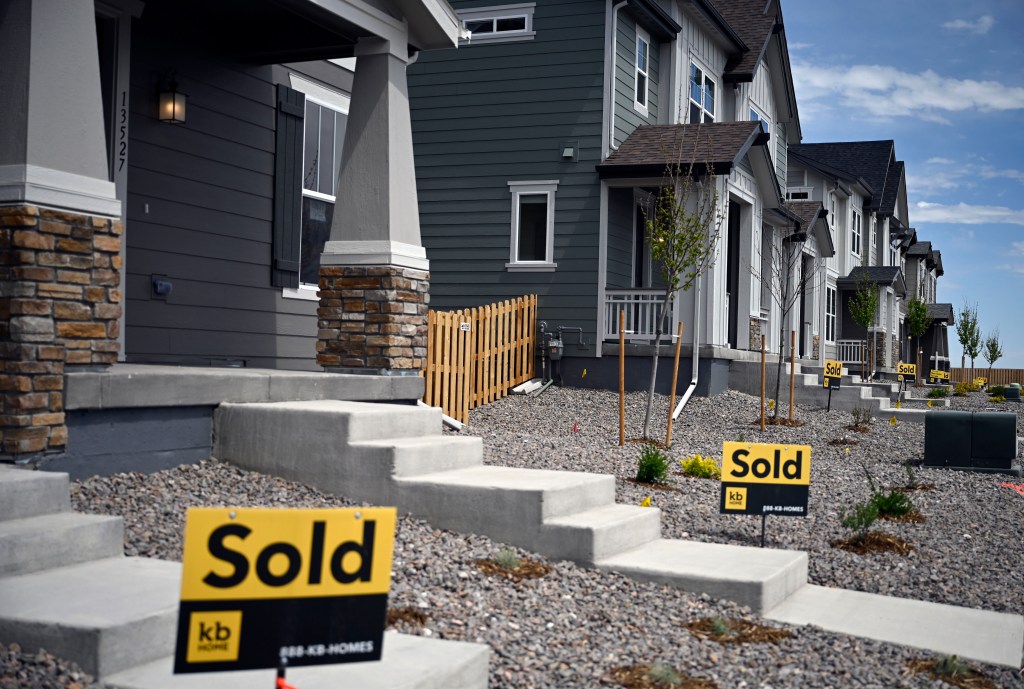World News
Homeownership is moving further out of reach for many Coloradans

Builders are finally making a dent in the state’s housing shortage, especially for apartments. But home prices and mortgage rates continue to outpace income growth, and affordability is worsening rather than improving.
“The story with interest rates is that they are making the problem worse,” said Steven Byers, chief economist at the Common Sense Institute in Denver. “The fact is that wages cannot keep up with these huge increases in house prices.”
For the first time since July 2022, home prices in all major U.S. metro areas, including Denver, increased year-over-year. reports brokerage firm Redfin. The S&P CoreLogic Case-Shiller Index for Denver saw home prices rise 2.7% over the year through February.
After five weeks of increases, the average interest rate on a 30-year loan reached 7.22%, the highest level since Thanksgiving, according to Freddie Mac.
Buying a house used to be difficult, and it’s only getting harder. In 2011, a buyer in Colorado could expect to work an average of 44 hours per month to cover the mortgage payment. That bar moved to 96 hours last year, an increase of 118%, he said CSI’s Colorado Housing Competitiveness Index, of which Byers was co-author.
It is only slightly better for tenants. In 2011, they had to work an average of 45 hours to pay the monthly rent. Now they have to work 87 hours. Renters in Colorado spend more hours per month paying rent than residents of any other state, according to the CSI report.
After the Great Recession, metro Denver became a hot spot for young professionals and tech workers looking to relocate. Demand for housing exceeded supply, causing home prices and rents to rise. Net domestic migration has fallen over the past two years as more people move and leave and fewer people move in, Byers said. Higher housing costs have made the state less attractive.
That is both good and bad. Slower population growth should ease pressure on the housing market and give builders time to catch up, stabilizing home prices and rents over time. But it also makes employers and the larger economy, which have long depended on importing needed talent, vulnerable. When the economy grinds to a halt, those struggling with the higher cost of living may pay the price.
Of the 50 largest U.S. metropolitan areas, only six have median home prices that match median incomes, a study finds study by Clever Real Estate. Denver had the eighth largest gap between the amount of income needed to reach a median-priced home.
Zillow estimates the typical home value in metro Denver at just $561,000 in December. Assuming a 20% down payment and at current mortgage rates, an annual income of $167,562 would be needed to purchase that home, according to the Clever Real Estate study.
But here’s where it gets painful. The median household income in the Denver metro is $98,975 per year, resulting in a deficit of $68,587. Denver residents earn above-average incomes, but the higher wages aren’t enough to cover the far-above-average housing costs.
Wages tend to be lower in other parts of the state, and the affordability “gap” is slightly larger statewide: $69,587. Colorado’s median home price is $531,900, not far behind the Denver metro median price. With a 20% discount, that requires an income of $158,889, according to Clever Real Estate. The statewide median household income is $89,302.
Without outside help, starters often have difficulty offering a 20% discount. That would require $112,200 for a typical Denver home. How could anyone afford to cut 10% and increase the average income in Denver after the recent increase in mortgage rates? Clever Real Estate estimates that amount closer to $270,000 to $280,000.
Good luck finding it. Of the 6,458 single-family home closings in metro Denver in the first three months of the year, only 50 involved a home priced under $300,000. the Denver Metro Association of Realtors.
Condominium and townhome buyers have better odds, with 452 of 2,343 sales under $300,000 this year. But even there, only 20% of homes are affordable for middle-income households. Only 5.7% of sales, houses or apartments, were feasible.
The barrier is even greater for buyers of new homes. The average price for a new home in Colorado is $650,000, according to a study by the National Association of Home Builders. Only one in five households in the state can afford something at that price. Two million households in the state cannot afford to buy a new home at the median price.
Rent cheaper now, but more expensive in the long term
Most renters have limited options when it comes to buying in metro Denver. But to their advantage, renting now offers a significant discount on buying, according to a separate analysis from Bankratethe personal finance website.
The typical monthly payment for the average-priced home is about $3,627 in metro Denver, including the mortgage payment, property taxes and insurance. In contrast, the typical rent is $2,027 when looking at a Zillow rent index that combines apartment, condo and house rental prices.
Renting was cheaper than buying in all fifty metros surveyed, but Denver had the ninth largest difference at $1,600. That 79% premium was much larger than the 36.6% premium you would own nationally.
“I wouldn’t say rent is affordable, but between buying and renting, renting is the lesser of two evils,” said Alex Gailey, lead data reporter at Bankrate and author of the analysis.
In an ideal world, renters would sock away that extra money as emergency savings. Then the savings would be invested in the stock market, which over time has produced higher returns than owning a house. If an employer matched the contribution to the pension plan, that would automatically translate into an automatic 50% return.
But most renters are unlikely to follow that strategy, leaving them vulnerable in the long run, Gailey acknowledges. If an area doesn’t lose population, homes should increase in value even after repairs and maintenance are taken into account.
That equity can be put toward purchasing a larger home in the future, or it can help fund retirement expenses or be passed on to children and heirs, building intergenerational wealth. Mortgage payments can also be recorded, while this is not the case with rental payments.
“You’re building equity for yourself instead of for someone else,” said Jen Ankrum, director of sales for KB Home in Colorado, when asked about the message the company shares with renters looking to buy.
First-time buyers account for about half of sales at KB Home, which strives to provide a high-quality, energy-efficient home that is below competitive prices. Even with the heavy focus on first-time buyers, about a third of buyers make less than $100,000, a third make $100,000 to $150,000 and a third make more than that amount.
Normally, the housing market tries to find an equilibrium, where rising interest costs are offset by slower price increases or even price decreases. But demographics have prevented that. Millennials, born between 1981 and 1996, are now the country’s largest generation with a population of 72 million. They are behind schedule compared to previous generations when it comes to purchasing homes and go to great lengths to acquire them, even when conditions are not favorable.
Markets where more millennials have moved because the housing market is under the most pressure. Just over six in 10 homebuyers in metro Denver are millennials – only San Francisco and San Jose in California and Boston have a higher share of millennial buyers, according to to a study by loan portal LendingTree.
None of these markets would be considered affordable. In Denver, millennial buyers made an average down payment of $70,710 and borrowed $456,805 to purchase a home, LendingTree reports.
“A big reason millennials focus on expensive housing markets is because those areas tend to have robust and relatively high-paying job markets,” said Jacob Channel, senior economist at LendingTree and author of the report.
Big tech companies are reducing their workforces and a recession, if it comes, could accelerate layoffs. What happens if those well-paying jobs disappear, but the high mortgage costs do not? But Channel sees no systemic risk to the housing market.
“While there are undoubtedly some millennials who are currently strapped for cash and facing the prospect of downsizing or, at worst, foreclosure, the number of people struggling is not large enough to pose a serious risk for the broader economy. housing market,” Channel said.
Get more real estate and business news by signing up for our weekly newsletter, On the Block.











